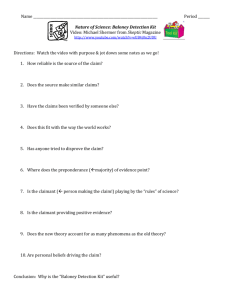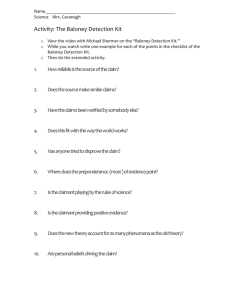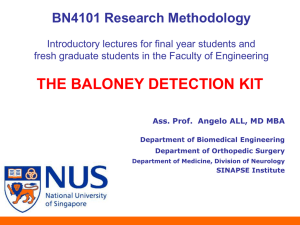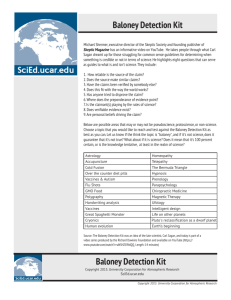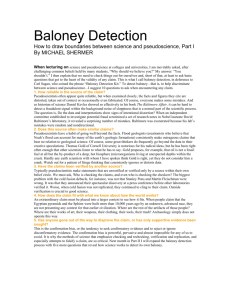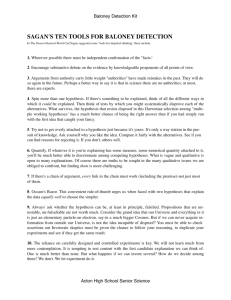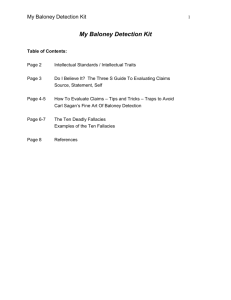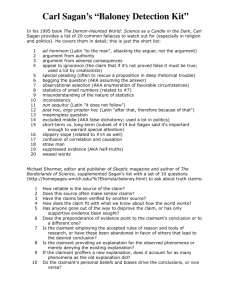PART 5: THE BALONEY DETECTION KIT Research and how to do it
advertisement
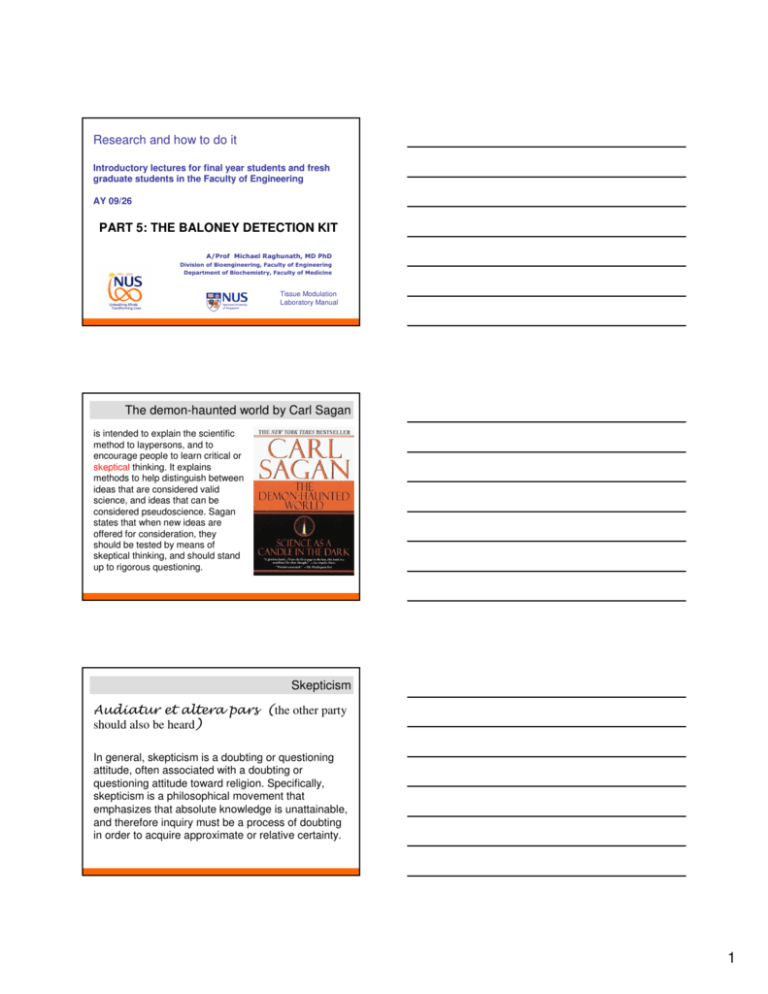
Research and how to do it Introductory lectures for final year students and fresh graduate students in the Faculty of Engineering AY 09/26 PART 5: THE BALONEY DETECTION KIT A/Prof Michael Raghunath, MD PhD Division of Bioengineering, Faculty of Engineering Department of Biochemistry, Faculty of Medicine Tissue Modulation Laboratory Manual The demon-haunted world by Carl Sagan is intended to explain the scientific method to laypersons, and to encourage people to learn critical or skeptical thinking. It explains methods to help distinguish between ideas that are considered valid science, and ideas that can be considered pseudoscience. Sagan states that when new ideas are offered for consideration, they should be tested by means of skeptical thinking, and should stand up to rigorous questioning. Skepticism Audiatur et altera pars (the other party should also be heard) In general, skepticism is a doubting or questioning attitude, often associated with a doubting or questioning attitude toward religion. Specifically, skepticism is a philosophical movement that emphasizes that absolute knowledge is unattainable, and therefore inquiry must be a process of doubting in order to acquire approximate or relative certainty. 1 The baloney detection kit • independent confirmation of the facts • encourage substantive debate on evidence by knowledgeable proponents of all points of view • arguments from authorities carry little weight (or better put, there are no authorities in science, only experts) • spin more than one hypothesis The baloney detection kit • • • • • do not get overly attached to a hypothesis Quantify (seek numerical quantity ) in a chain of argument, every link must work apply Occam’s Razor always ask whether a hypothesis can be falsified Like: All swans are white. If only one black swan can be found, this hypothesis is falsified. The baloney detection kit Additional issues are • Conduct control experiments • Check for confounding factors - separate the variables. 2 Common fallacies of logic and rhetoric •Ad hominem - attacking the arguer and not the argument. •Argument from "authority". •Argument from adverse consequences (putting pressure on the decision maker by pointing out dire consequences of an "unfavourable" decision). •Appeal to ignorance (absence of evidence is not evidence of absence). (We did not see this and that means that (you just didn’t look!) •Special pleading (typically referring to god's will). The baloney detection kit •Begging the question (assuming an answer).”The stock market fell yesterday because of a technical adjustment and profit-taking by investors) •Observational selection (counting the hits and forgetting the misses). •Statistics of small numbers (such as drawing conclusions from inadequate sample sizes). •Misunderstanding the nature of statistics (President Eisenhower expressing astonishment and alarm on discovering that fully half of all Americans have below average intelligence!) •Inconsistency (e.g. military expenditures based on worst case scenarios but scientific projections on environmental dangers thriftily ignored because they are not "proved"). The baloney detection kit •Non sequitur - "it does not follow" - the logic falls down. •Post hoc, ergo propter hoc - "it happened after so it was caused by" - confusion of cause and effect. The street was wet so it has rained •Meaningless question ("what happens when an irresistible force meets an immovable object?). •Excluded middle - considering only the two extremes in a range of possibilities (making the "other side" look worse than it really is). •Short-term v. long-term - a subset of excluded middle ("why pursue fundamental science when we have so huge a budget deficit?"). 3 The baloney detection kit •Slippery slope - a subset of excluded middle - unwarranted extrapolation of the effects (give an inch and they will take a mile). •Confusion of correlation and causation. •Straw man - caricaturing (or stereotyping) a position to make it easier to attack.. •Suppressed evidence or half-truths. •Weasel words - for example, use of euphemisms for war such as "police action" to get around limitations on Presidential powers. “ or “salary adjustment” you must ask the following 10 questions 1. How reliable is the source of the claim? These 10 Questions and subtexts are from Michael Shermer’s article “Baloney Detection in Scientific American 16 November 2001 , own words are in [ ] • a given newspaper or TV channel • a published book (not peer reviewed) • a published article (not peer reviewed) • a published article in a scientific journal (peer reviewed) • advertisement Pseudoscientists often appear quite reliable, but when examined closely, the facts and figures they cite are distorted, taken out of context or occasionally even fabricated. [ A couple of published books (look at the self-improvement shelves), contain claims that are not backed up by cited work] you must ask the following questions 2. Does this source often make similar claims? “Pseudoscientists have a habit of going well beyond the facts. Flood geologists (creationists who believe that Noah's flood can account for many of the earth's geologic formations) consistently make outrageous claims that bear no relation to geological science. Of course, some great thinkers do frequently go beyond the data in their creative speculations. Their peers might think they are wrong but not that they are cranks.” 4 you must ask the following questions 3. Have the claims been verified by another source? “Typically pseudoscientists make statements that are unverified or verified only by a source within their own belief circle. We must ask, Who is checking the claims, and even who is checking the checkers? Example cold fusion: Stanley Pons and Martin Fleischman announced their spectacular discovery at a press conference before other laboratories verified it. Worse, when cold fusion was not replicated, they continued to cling to their claim. Outside verification is crucial to good science.” you must ask the following questions 4. How does the claim fit with what we know about how the world works? “An extraordinary claim must be placed into a larger context to see how it fits. When people claim that the Egyptian pyramids and the Sphinx were built more than 10,000 years ago by an unknown, advanced race, they are not presenting any context for that earlier civilization. Where are the rest of the artifacts of those people? Where are their works of art, their weapons, their clothing, their tools, their trash? Archaeology simply does not operate this way. “ you must ask the following questions 5. Has anyone gone out of the way to disprove the claim, or has only supportive evidence been sought? “This is the confirmation bias, or the tendency to seek confirmatory evidence and to reject or ignore disconfirmatory evidence. The confirmation bias is powerful, pervasive and almost impossible for any of us to avoid. It is why the methods of science that emphasize checking and rechecking, verification and replication, and especially attempts to falsify a claim, are so critical. “ 5 you must ask the following questions 6. Does the preponderance of evidence point to the claimant's conclusion or to a different one? “The theory of evolution, for example, is proved through a convergence of evidence from a number of independent lines of inquiry. No one fossil, no one piece of biological or paleontological evidence has "evolution" written on it; instead tens of thousands of evidentiary bits add up to a story of the evolution of life. Creationists conveniently ignore this confluence, focusing instead on trivial anomalies or currently unexplained phenomena in the history of life.” you must ask the following questions 7. Is the claimant employing the accepted rules of reason and tools of research, or have these been abandoned in favor of others that lead to the desired conclusion? “A clear distinction can be made between SETI (Search for Extraterrestrial Intelligence) scientists and UFOlogists. SETI scientists begin with the null hypothesis that ETIs do not exist and that they must provide concrete evidence before making the extraordinary claim that we are not alone in the universe. In contrast, UFOlogists begin with the positive hypothesis that ETIs exist and have visited us, then employ questionable research techniques to support that belief, such as hypnotic regression (revelations of abduction experiences), anecdotal reasoning (countless stories of UFO sightings), conspiratorial thinking (governmental cover-ups of alien encounters), lowquality visual evidence (blurry photographs and grainy videos), and anomalistic thinking (atmospheric anomalies and visual misperceptions by eyewitnesses)”. you must ask the following questions 8. Is the claimant providing an [own (scientific] explanation for the observed phenomena or merely denying the existing explanation? “This is a classic debate strategy- criticize your opponent and never affirm what you believe yourself to avoid criticism. It is next to impossible to get creationists to offer an explanation for life (other than "God did it"). Intelligent Design (ID) creationists have done no better, picking away at weaknesses in scientific explanations for difficult problems and offering in their stead "ID did it." This stratagem is unacceptable in science.” 6 you must ask the following questions 9. If the claimant proffers a new explanation, does it account for as many phenomena as the old explanation did? “Many HIV/AIDS skeptics argue that lifestyle causes AIDS [like only gay men get it, wrong life style]. Yet their alternative theory does not explain nearly as much of the data as the HIV theory does. To make their argument, they must ignore the diverse evidence in support of HIV as the causal vector in AIDS while ignoring the significant correlation between the rise in AIDS among hemophiliacs [most of them who were heterosexual] shortly after HIV was inadvertently [also deliberately by companies using cheaper sources of blood] introduced into the blood supply.” you must ask the following questions 10. Do the claimant's personal beliefs and biases drive the conclusions, or vice versa? “All scientists hold social, political and ideological beliefs that could potentially slant their interpretations of the data, but how do those biases and beliefs affect their research in practice? Usually during the peer-review system, such biases and beliefs are rooted out, or the paper or book is rejected. “ These 10 Questions and subtexts are from Michael Shermer’s article “Baloney Detection in Scientific American 16 November 2001 , own words are in [ ] The 11th question (M. Raghunath) 11. Qui bono ? (who does benefit from other people believing the claim ?) Are there commercial interests behind this claims leading to a line of research or claimed results Does this foster the advancement of a field, contribute to knowledge or does this just lead to the filling on someone’s purse ? For this very reason, reputable journals demand from authors to disclose any conflicts of interest. Classical example: scientists that publish about a pharmacological substance and are shareholders of this company making this drug OR clinicians conducting trials while being consultants or board member of the company making this drug. 7 Example black chicken Do you know what is said about it ? “Black chicken is particularly nutricious” • what is nutricious ? How is it defined • how are the alleged effects proven ? • can a single food stuff help in so many different disorders ? (anti-aging, antidiabetes, anti-autism) 8 The currently ( 14 August 2008) 16 publications on silky fowl in PubMed focus merely on genetic and histological abnormalities. However, Toyosaki’s work (2004 and 2007) might point out to a highter degree of unsaturated fat in silky fowl eggs with antioxidant properties. Other work that has appeared as an abstract has not been published in full yet. And 100 SGD go to the first NUS student That shows me convincing – peer reviewed scientific proof published on this often used claim (next slide) on how much knowledge is retained hearing it, seing it, doing it etc. bierm@nus.edu.sg This claim is been used over and over again in seminars all over the world, but on which data is this claim based on ? Retention of Information according to its Presentation 90% do it yourself 70% tell yourself audio-visual 50% 30% visual audio Is this really so, where is the data ? 20% read 10% 0 20 40 60 80 100 9 The Meaning of your research training To fit you out with a baloney detection kit 10
